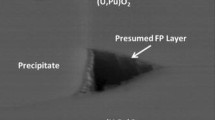Abstract
During the fast reactor nuclear fuel fission reaction, fission gases accumulate and form pores with the increase of fuel burnup, which decreases the fuel thermal conductivity, leading to overheating of the fuel element. The diffusion of plutonium and oxygen with high temperature gradient is also one of the important fuel performance concerns as it will affect the fuel material properties, power distribution, and overall performance of the fuel pin. In order to investigate these important issues, the (U1−y Pu y )O2−x fuel pellet is studied by fully coupling thermal transport, deformation, oxygen diffusion, fission gas release and swelling, and plutonium redistribution to evaluate the effects on each other with burnup-dependent models, accounting for the evolution of fuel porosity. The approach was developed using self-defined multiphysics models based on the framework of COMSOL Multiphysics to manage the nonlinearities associated with fast reactor mixed oxide fuel performance analysis. The modeling results showed a consistent fuel performance comparable with the previous results. Burnup degrades the fuel thermal conductivity, resulting in a significant fuel temperature increase. The fission gas release increased rapidly first and then steadily with the burnup increase. The fuel porosity increased dramatically at the beginning of the burnup and then kept constant as the fission gas released to the fuel free volume, causing the fuel temperature to increase. Another important finding is that the deviation from stoichiometry of oxygen affects greatly not only the fuel properties, for example, thermal conductivity, but also the fuel performance, for example, temperature distribution, porosity evolution, grain size growth, fission gas release, deformation, and plutonium redistribution. Special attention needs to be paid to the deviation from stoichiometry of oxygen in fuel fabrication. Plutonium content will also affect the fuel material properties and performance. However, it is not that significant compared to the deviation from stoichiometry of oxygen due to the similar material properties of UO2 and PuO2.










Similar content being viewed by others
References
K. Maeda, S. Sasaki, M. Kato, Y. Kihara, J. Nucl. Mater. 389(1), 78–84 (2009)
A. Karahan: Ph.D. Thesis, Massachusetts Institute of Technology, 2009
M. Ishida, T. Ogata, M. Kinoshita, Nucl. Technol. 104(1), 37–51 (1993)
K. Lassmann, J. Nucl. Mater. 150(1), 10–16 (1987)
C.F. Clement, M.W. Finnis, J. Nucl. Mater. 75(1), 193–200 (1978)
T. Ishii, T. Asaga, J. Nucl. Mater. 294(1–2), 13–17 (2001)
B. Mihaila, M. Stan, J. Crapps, J. Nucl. Mater. 430(1–3), 221–228 (2012)
B. Mihaila, M. Stan, J. Crapps, D. Yun, J. Nucl. Mater. 433(1–3), 132–142 (2013)
M. Teague, M. Tonks, S. Novascone, S. Hayes, J. Nucl. Mater. 444(1–3), 161–169 (2014)
D. Yun, M. Stan, J. Mater. Res. 28(17), 2308–2315 (2013)
D. Olander: Fundamental Aspects of Nuclear Reactor Fuel Elements, Technical Information Center, Energy Research and Development Administration, 1976
J.C. Ramirez, M. Stan, P. Cristea, J. Nucl. Mater. 359(3), 174–184 (2006)
C. Sari, G. Schumacher, J. Nucl. Mater. 61(2), 192–202 (1976)
S.R.D. Groot, Thermodynamics of Irreversible Processes (North Holland Publ. Co, Amsterdam, 1951)
C. Korte, J. Janek, and H. Timm: Solid State Ionics, 1997, vol. 101–103, Part 1(0), pp. 465–70
D. Morgan: MASc Thesis, Royal Military College of Canada, 2007
C.M. Allison, G.A. Berna, R. Chambers, E.W. Coryell, K.L. Davis, D.L. Hagrman, D.T. Hagrman, N.L. Hampton, J.K. Hohorst, R.E. Mason, M.L. McComas, K.A. McNeil, R.L. Miller, C.S. Olsen, G.A. Reymann, and L.J. Siefken: SCDAP/RELAP5/MOD3.1 Code Manual Volume IV: MATPRO-A Library of Materials Properties for Light-Water-Reactor Accident Analysis, NUREG/CR-6150, 1993
K. Shaheen: Ph.D. Thesis, Royal Military College of Canada, 2011
A.H. Booth: A Method of Calculating Fission Gas Diffusion from UO2 Fuel and Its Application to the X-2-f Loop Test. AECL, 1957. 496
C. Sari, J. Nucl. Mater. 137(2), 100–106 (1986)
G.V. Kidson, J. Nucl. Mater. 88(2–3), 299–308 (1980)
R.J. White, M.O. Tucker, J. Nucl. Mater. 118(1), 1–38 (1983)
J.J. Carbajo, G.L. Yoder, S.G. Popov, V.K. Ivanov, J. Nucl. Mater. 299(3), 181–198 (2001)
J.K. Fink, J. Nucl. Mater. 279(1), 1–18 (2000)
R.L. Gibby, L. Leibowitz, J.F. Kerrisk, D.G. Cliffton, J. Nucl. Mater. 50(2), 155–161 (1974)
I.J. Hastings, L.E. Evans, J. Am. Ceram. Soc. 62(3–4), 217–218 (1979)
V. Di Marcello, A. Schubert, J. van de Laar, and P. Van Uffelen: Revision of the transuranus PUREDI model, Technical report for the JRC-ITU Action No. 52201—Safety of Nuclear Fuels and Fuel cycles, European Commission, Joint Research Centre, Institute for Transuranium Elements, 2012
Acknowledgments
The financial support from the Hong Kong Early Career Scheme Grant (No. 9048010) and CityU Start-up and Equipment Grants (No. 7200343 and No. 9610289) is highly appreciated.
Author information
Authors and Affiliations
Corresponding author
Additional information
Manuscript submitted July 23, 2015.
Rights and permissions
About this article
Cite this article
Liu, R., Zhou, W. & Zhou, W. Fully Coupled Modeling of Burnup-Dependent (U1−y , Pu y )O2−x Mixed Oxide Fast Reactor Fuel Performance. Metallurgical and Materials Transactions E 3, 18–27 (2016). https://doi.org/10.1007/s40553-015-0065-6
Published:
Issue Date:
DOI: https://doi.org/10.1007/s40553-015-0065-6




